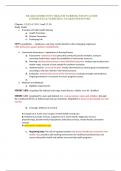NR 442 COMMUNITY HEALTH NURSING STUDY GUIDE
(COMPLETE & VERIFIED ) GUARANTEED PASS
Chapters 1,2,4,5, 6,7,10,11 and 12, 26
Study Guide
1. Principles of Public Health Nursing
a. Health Promotion
b. Disease Prevention
c. Prolonging Life
HIPPA guidelines -- employees can keep certain benefits when changing employees
offer protection against patient confidentially.
2. Community Assessment – Application of Nursing Process
a. Assessment- collection of data about the community and its members, evaluate
secondary health data, assess the availability of community resources
b. Planning- develop interventions to meet identified outcomes. Analyze data to determine
health needs, amount of time needed for problem resolution
c. Implementation- carry out the plan, initiate interventions to achieve goals and objectives
according to the plan. Monitor intervention process.
d. Evaluation- examine the success of the interventions. Evaluate strength and weakness.
Ongoing evaluation is necessary to ensure program success.
e.
3. Medicare and Medicaid
a. Eligibility requirements:
MEDICARE: (regulated by federal) end stage renal disease, elderly over 65, disabled
MEDICAID: (regulated by state and federal) low socioeconomic status and children, through
the combined efforts of federal and state governments. Eligibility is based on household size and
income.
b. Coverage- Medicare A, B and D
A: hospital care, home care, hospice, limited skilled nursing care
B: healthcare provider services, outpatient care, home health, diagnostic services,
physiotherapy, durable medical equipment, ambulance services, mental health, preventive
services
D: prescription medications only.
c. Regulating body: The role of regulatory bodies is to protect healthcare consumers from
health risks, provide a safe working environment for healthcare professionals, and
ensure that public health and welfare are served by health programs.
, 4. Medicaid
a. Eligibility: low income.
b. Challenges: They will have a decreased financial ability to opt for elective treatments,
and they may not be able to pay for top brand drugs or other medical aids
5. Isolation precaution, Chains of transmission and manifestations
a. HIV: Standard precaution, contact transmission.
b. Sexually transmitted infections/ diseases: Standard precaution, contact transmission.
c. TB: Airborne isolation, coughing, weight loss, lack of appetite, hemoptysis.
d. EBOLA: droplet/contact, spread through coughing, sneezing, and body fluids. s/s include
fever, fatigue, diarrhea, vomiting, stomach pain
e. Measles: airborne isolation, highly contagious, flu like symptoms, fever, runny nose, red
eyes, rash, white spots on tongue
f. Anthrax: contact precaution, fever, chills, muscle aches, chest discomfort, severe
dyspnea, shock
g. Botulism: foodborne, standard isolation, double vision, slurred speech, difficulty
swallowing and breathing, progressive muscle weakness
h. Pertussis: airborne isolation, sneezing, low fever, mild cough then becomes severe,
barking cough
i. Chlamydia/ STDs: standard precaution, sexual contact, silent infection, pain in urination,
inflammation of urethra
j. West Nile Virus: vector- borne
k. Smallpox: airborne and contact isolation, fever, fatigue, head and body aches, rash on
face trunk legs hands and feet, vomiting.
6. Levels of Prevention in Various Healthcare settings/ populations
a. Primary: Prevent – EDUCATE!
b. Secondary: Screen
c. Tertiary: Treat
7. Reportable Notifiable diseases
a. Passive Surveillance: local and state health departments rely on healthcare providers or
labs to report a disease. This is more efficient. Only requires few resources.
- disadvantage: incomplete data due to underreporting. Only wait for
health care providers or labs to report the diseases
b. Active Surveillance: health department will call providers or labs requesting information
to identify possible cases. It needs more resources. (ex. If a hospital has a confirmed case
of HIV. The IDPH will call the hospital to get more information about the patient. the
patient demographics S/S. what diagnostic tests were done and how they are being
treated). The department needs more specific information about the disease
8. Health People 2030 Health Indicators:




